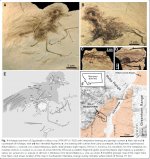Fred Ruhe
Well-known member

Tobin L. Hieronymus, David A. Waugh1 & Julia A. Clarke, 2019
A new zygodactylid species indicates the persistence of stem passerines into the early Oligocene in North America
BMC Evolutionary Biology201919:3
Abstract: https://bmcevolbiol.biomedcentral.com/articles/10.1186/s12862-018-1319-6
Background: The lake deposits of the informal Ruby Paper Shale unit, part of the Renova Formation of Montana, have yielded abundant plant fossils that document Late Eocene – Early Oligocene global cooling in western North America. A nearly complete small bird with feather impressions was recovered from this unit in in 1959, but has only been informally mentioned.
Results: Here we describe this fossil and identify it as a new species of Zygodactylus, a stem lineage passerine with a zygodactyl foot. The new taxon shows morphological traits that are convergent on crown Passeriformes, including an elongate hallux, reduced body size, and a comparative shortening of proximal limb elements. The fossil documents
the persistence of this lineage into the earliest Oligocene (~ 33 Ma) in North America. It is the latest occurring North American species of a group that persists in Europe until the Miocene.
Conclusions: Eocene-Oligocene global cooling is known to have significantly remodeled both Palearctic and Nearctic mammal faunas but its impact on related avifaunas has remained poorly understood. The geographic and temporal range expansion provided by the new taxon together with avian other taxa with limited fossil records suggests a similar pattern of retraction in North America followed by Europe.
Keywords: Passeriformes, Paleogene, Paleobiogeography, Zygodactylidae
The new species described is Zygodactylus ochlurus sp. nov.
Free pdf: https://bmcevolbiol.biomedcentral.com/track/pdf/10.1186/s12862-018-1319-6
Enjoy,
Fred
A new zygodactylid species indicates the persistence of stem passerines into the early Oligocene in North America
BMC Evolutionary Biology201919:3
Abstract: https://bmcevolbiol.biomedcentral.com/articles/10.1186/s12862-018-1319-6
Background: The lake deposits of the informal Ruby Paper Shale unit, part of the Renova Formation of Montana, have yielded abundant plant fossils that document Late Eocene – Early Oligocene global cooling in western North America. A nearly complete small bird with feather impressions was recovered from this unit in in 1959, but has only been informally mentioned.
Results: Here we describe this fossil and identify it as a new species of Zygodactylus, a stem lineage passerine with a zygodactyl foot. The new taxon shows morphological traits that are convergent on crown Passeriformes, including an elongate hallux, reduced body size, and a comparative shortening of proximal limb elements. The fossil documents
the persistence of this lineage into the earliest Oligocene (~ 33 Ma) in North America. It is the latest occurring North American species of a group that persists in Europe until the Miocene.
Conclusions: Eocene-Oligocene global cooling is known to have significantly remodeled both Palearctic and Nearctic mammal faunas but its impact on related avifaunas has remained poorly understood. The geographic and temporal range expansion provided by the new taxon together with avian other taxa with limited fossil records suggests a similar pattern of retraction in North America followed by Europe.
Keywords: Passeriformes, Paleogene, Paleobiogeography, Zygodactylidae
The new species described is Zygodactylus ochlurus sp. nov.
Free pdf: https://bmcevolbiol.biomedcentral.com/track/pdf/10.1186/s12862-018-1319-6
Enjoy,
Fred




